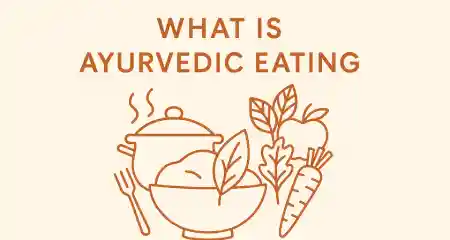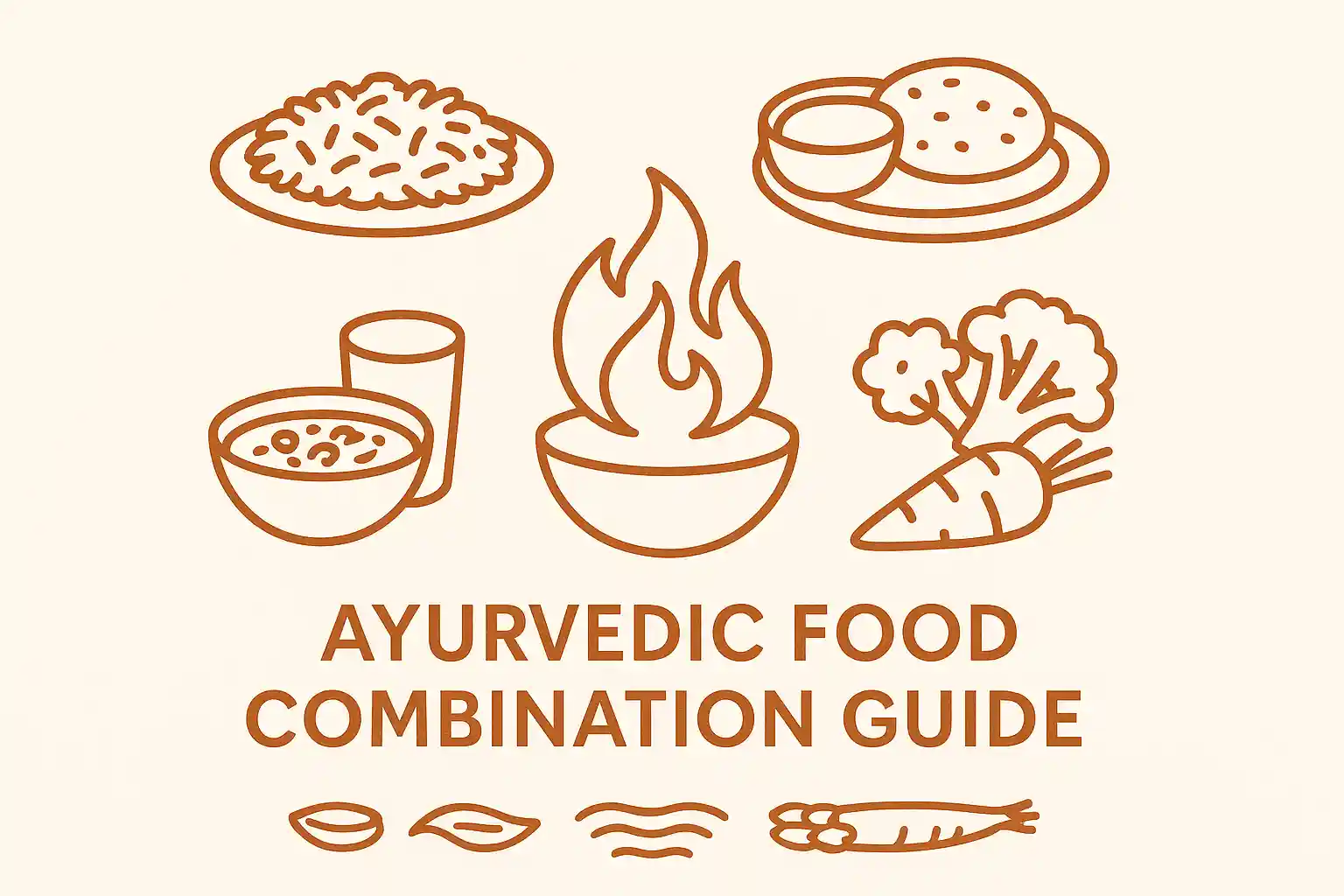Why Food Combining Is Essential in Ayurveda
At the heart of Ayurvedic nutrition lies the concept of Agni — your digestive fire. When Agni is strong, food is properly digested, absorbed, and transformed into Ojas (vital essence). When Agni is weak or disturbed, food becomes only partially digested, leading to the formation of Ama (toxins), a root cause of disease.
Food combining—known as Viruddha Ahara in classical texts—is one of the most effective ways to protect and strengthen Agni, especially when eating on the go or traveling. Certain combinations of foods can disturb digestion by introducing conflicting qualities (Gunas), tastes (Rasas), or post-digestive effects (Vipaka), or by confusing digestive signals.
"Incompatible foods impair digestion, derange Doshas, and obstruct channels."
How Improper Combining Disturbs Digestion
Incompatible food pairings can:
- Weaken Agni
- Slow digestion
- Produce Ama
- Aggravate specific Doshas, leading to imbalance and disease
Examples of disturbed Agni:
- Sour fruit + milk → curdling and fermentation in the stomach
- Fish + dairy → conflicting temperatures and qualities, leading to sluggish digestion
- Hot drinks + honey → chemically alters honey, producing toxicity
The Deeper Ayurvedic View on Food Combining
You may wonder — why does Ayurveda teach that certain food combinations are harmful? The answer lies in the subtle qualities of food and how they interact with your body's digestive fire (Agni) and Dosha balance.
In Ayurveda, food isn't evaluated just by calories or nutrients — it is understood through a rich system of qualities and effects:
Opposing Gunas (Qualities)
Every food carries certain Gunas, or inherent qualities. These include:
- Heavy or light
- Cold or hot
- Oily or dry
- Stable or mobile
When we combine foods with opposing Gunas, we send contradictory signals to the digestive system. For example:
A heavy, cold food (like yogurt) combined with a light, heating food (like sour fruit) can confuse Agni, slowing digestion and promoting Ama (toxins).
Conflicting Rasas (Tastes)
In Ayurveda, there are six tastes or Rasas:
Sweet, Sour, Salty, Bitter, Pungent, Astringent
Each taste influences Agni and Dosha balance in specific ways. Certain taste combinations overwhelm Agni or cause imbalance.
For example: Combining sweet, sour, and salty tastes in one meal can overstimulate the digestive system, leading to incomplete digestion.
Conflicting Vipaka (Post-Digestive Effect)
Every food also has a Vipaka, or post-digestive effect — the influence it exerts on the body after digestion is complete.
- Some foods leave a sweet post-digestive effect, nourishing and building tissues.
- Others may leave a pungent or sour effect, stimulating metabolism or elimination.
When foods with opposing Vipakas are eaten together, they can disrupt the natural progression of digestion and assimilation — leading to subtle disharmony and eventual Ama.
Contradictory Impact on Doshas
Each food naturally influences the three Doshas (Vata, Pitta, Kapha):
- Some foods pacify one Dosha while aggravating another.
- When you combine foods that send conflicting signals to your Doshas, the body struggles to process them smoothly.
Example: A food that increases Kapha (heavy, sweet) combined with one that reduces Kapha (light, pungent) can confuse the body's regulatory mechanisms, weakening Agni and promoting Ama formation.
Most Common Incompatible Food Combinations
1. Milk + Sour Fruits
Why it's problematic: Sour fruits cause milk to curdle in the stomach, producing heaviness, sluggish digestion, bloating, and Ama accumulation. This can also promote Kapha imbalance (mucus) and Pitta aggravation (inflammation).
Better alternative: Enjoy fruits on their own, especially citrus, berries, or sour varieties.
2. Milk + Fish
Why it's problematic: Combining fish with milk can confuse Agni and create internal toxicity. Classically associated with skin conditions (eczema, rashes) and toxin accumulation.
Better alternative: Enjoy fish with vegetables and grains, not dairy.
3. Yogurt + Fruit
Why it's problematic: This combination promotes mucus formation (Kapha), impairs digestion, and encourages Ama formation. Fermentation in the gut can lead to gas, bloating, and skin imbalances.
Better alternative: Eat yogurt with warming spices (ginger, cumin) — skip the fruit.
4. Bananas + Milk
Why it's problematic: Though often used in smoothies, this combination is very hard to digest. It produces heaviness, Kapha accumulation (mucus), and potential toxin formation.
Better alternative: Eat bananas or drink milk separately.
5. Ghee + Honey in Equal Quantities
Why it's problematic: Classical Ayurveda warns that equal parts ghee + honey become toxic (particularly when heated). The combination is said to impair Agni, increase Ama, and harm tissue metabolism.
Better alternative: Use them in different parts of a meal or in unequal amounts.
6. Hot Drinks + Honey
Why it's problematic: Heating honey over 104°F (~40°C) chemically alters it, making it hard to digest and potentially toxic.
Better alternative: Add honey only to warm (not hot) liquids.
7. Radish + Milk
Why it's problematic: This combination overwhelms Agni and is classically linked to Ama and skin issues. Radish's pungency + milk's heaviness create internal conflict.
Better alternative: Pair radish with grains and vegetables — avoid dairy.
8. Meat + Dairy
Why it's problematic: Combining two heavy, rich foods overloads digestion. Common effects include sluggish digestion, Ama formation, Kapha increase, and fatigue.
Better alternative: Enjoy meat with lighter grains and vegetables — skip dairy.
Signs You May Be Eating Incompatible Foods
Watch for:
- Bloating, gas
- Sluggish digestion
- Fatigue after meals
- Skin issues (rashes, acne)
- Mucus buildup
- Mental fog
- Frequent cravings for heavy/imbalanced pairs
How to Practice Better Food Combining
- ✅ Favor simple meals — fewer ingredients digest best
- ✅ Eat fruit alone — especially melons & sour fruits
- ✅ Avoid dairy + meat/fish/sour foods
- ✅ Wait 1–2 hrs between conflicting foods
- ✅ Listen to your body — sluggish? bloated? adjust accordingly
• Vata: Sensitive to bloating → watch dairy + raw fruit combos
• Pitta: Prone to skin issues → avoid sour + heating pairs
• Kapha: Sluggish digestion → avoid heavy, cold, dairy-rich combos
Not sure of your Dosha? Take our Dosha Quiz.
Final Thoughts
Ayurveda teaches that how we combine foods is just as important as what we eat.
By avoiding key incompatible pairings and respecting your body's signals, you can:
- Protect your digestive fire (Agni)
- Prevent Ama buildup
- Support your Dosha balance
- Promote vitality and long-term wellness
Start gradually: Simplify meals, favor compatible combinations, and let your digestion be your guide.
Food combining works best as part of a broader Ayurvedic lifestyle — mindful eating, seasonal balance, and alignment with your unique constitution.
Frequently Asked Questions
Common questions about Ayurvedic food combining principles
Continue Your Learning Journey
Master the foundations of Ayurvedic eating with our structured learning path
Next: Learn how to adapt your diet through the seasonsReady to take the next step?
Explore personalized Ayurvedic guidance with our interactive tools designed to support your wellness journey.
Related Articles

What Is Agni? A Beginner's Guide to Ayurvedic Digestive Fire
Discover Agni, the vital digestive fire in Ayurveda that transforms food into energy and health. Learn the 4 types of Agni, signs of imbalance, and practical ways to strengthen your digestive fire naturally.
12 min read
What Is Ayurvedic Eating? A Complete Guide to Ancient Nutrition Wisdom
Discover the ancient holistic approach to food that goes beyond calories and nutrients. Learn how Ayurvedic eating aligns with your body, mind, and constitution for optimal health and wellness.
8 min read
